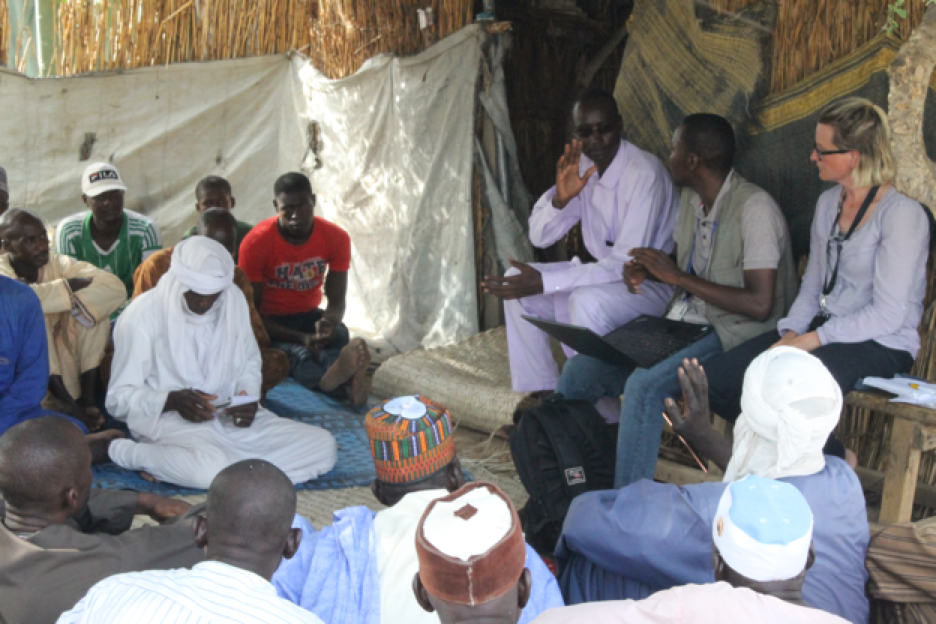A Donor Looks at Translating Accountability to Affected Populations Commitments into Reality
Linda Öhman, Senior Program Manager at Sida, shares her experiences of accountability to affected populations in practice in Chad, following a joint monitoring visit that took place between 11 to 18 June 2019.
Thanks to the support of the Swedish international development cooperation agency (Sida), the CHS Alliance and Ground Truth Solutions (GTS) have been working with the Chad Humanitarian Country Team since the beginning of 2018 to collect feedback from affected people and aid workers. Based on findings, we help aid agencies to implement programmes that are informed and adapted to the views, perceptions and priorities of the people they aim to serve. Reports highlighting the results and recommendations of this work can be found on the GTS’s website.
Thanks for joining our mission to Chad. Could you share your reflections? Do you have any memories you’d like to share?
Thank you. It was my first time in Chad, so needless to say the country left a strong impression, specifically the landscape and the people living in the Lake region – whether members of the displaced community or those working there. But more importantly, and more linked to the purpose of the trip, this was a very good opportunity to see firsthand the implementation of the work that I had so far only read about in reports. This was indeed an opportunity to see words – and here not the reporting but also all the theory that goes into explaining accountability to affected populations (AAP) – in real action. Finally, I very much appreciated hearing the overall positive reflections that many humanitarian actors shared with me. Not just because of the actual effect the project is having, but also that the humanitarian community takes AAP and communication with the community seriously.

© Guillaume Pocard, Ground Truth Solutions
How do you feel about the perception surveys undertaken by humanitarian workers? Do you feel donors should support these more broadly to strengthen accountability to affected populations?
I think the surveys are one very good way to gather concrete information as to the perceptions of people whom we as humanitarians serve. It is important in that this is actually looking at the collective response, rather than individual organisations’ actions, and conducted by an external actor who is not operational. The surveys are useful in that they present very clearly the thoughts and ideas of the communities. For Sida, who has AAP as one of four pillars in our humanitarian strategy, finding ways to work so concretely with AAP is important.
That does not mean perception surveys are the only way, nor can they be a standalone product. It is clear that they need to be accompanied by other work to take the information forward. This falls not only on us as humanitarians but all other stakeholders, including the community themselves. I do think we and other donors ought to look for ways support these kinds of efforts, so to translate our commitments on AAP into reality. Yet acknowledging that these surveys are a compass rather than a map, pointing the way but not giving directions, we also need to look for ways to ensure that our funding goes to organisations that act on the data they receive, and where this action is reflected in their work.
Sida is funding a number of stakeholders in Chad, including CHS Alliance members. What recommendations would you like to share with them?
We are keen to better understand how the data that is collected through the surveys is considered in the actual programming, particularly with an eye to the quality of the response. We want to see how it has informed and helped organisations to prioritise their work, to make sure that their activities do indeed respect the affected population. We will be looking at this more closely.
“What we [as donors] perhaps need to focus more on, is how to make sure this flexibility can be quick so adaptiveness is not bogged down in administrative process.”
Sida has been promoting Good Humanitarian Donorship principles among other donors. It recognises the importance of quality funding like core funding, and funding that can adapt based on feedback from affected populations. Based on what you’ve seen through this project, what recommendations would you have for other donors?
As donors we definitely have a role to play in providing possibilities for more agile program management, that can be quick and reactive – as this is the nature of a humanitarian response. Sweden’s humanitarian assistance – like many other donors – is in many ways flexible, not only through core funding. What we perhaps need to focus more on, is how to make sure this flexibility can be quick so adaptiveness is not bogged down in administrative process. And in parallel, our operational partners must also work to revise some aspects of their program management so to be able to quickly adjust to a changing context.
Any final words you would like to leave us with, particularly on how promoting and applying the Core Humanitarian Standard system-wide can make aid work better for people?
The elements set forth in the CHS are of great importance for improving the actual quality of the humanitarian response. The way in which the standard has served as a basis for the questions in the perception surveys both grounds the data collection in something concrete and provides a clear direction of where we need to go. We’ve come further with regards to meeting minimum standards on technical specifications in the work. Yet we need to do more with regards to working towards improved quality as this can make a difference not only short-term but also long-term in people’s lives – which ultimately is what defines the actual impact of a humanitarian response.
